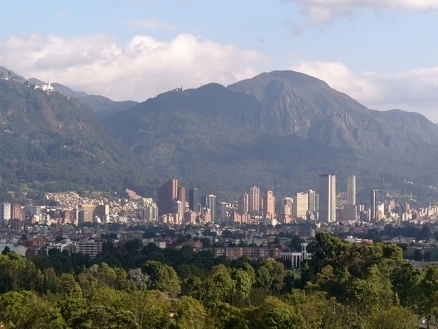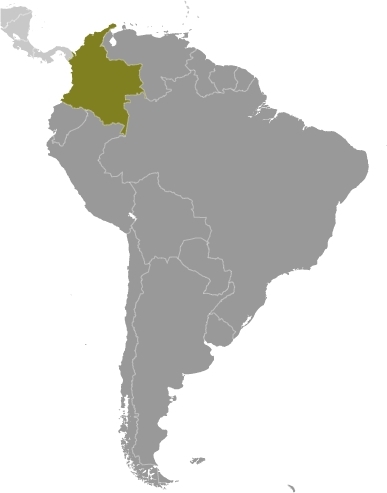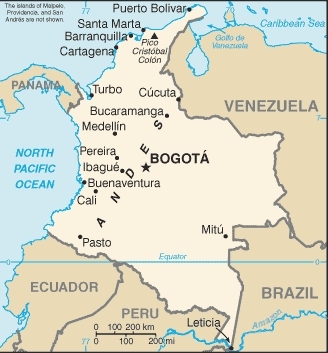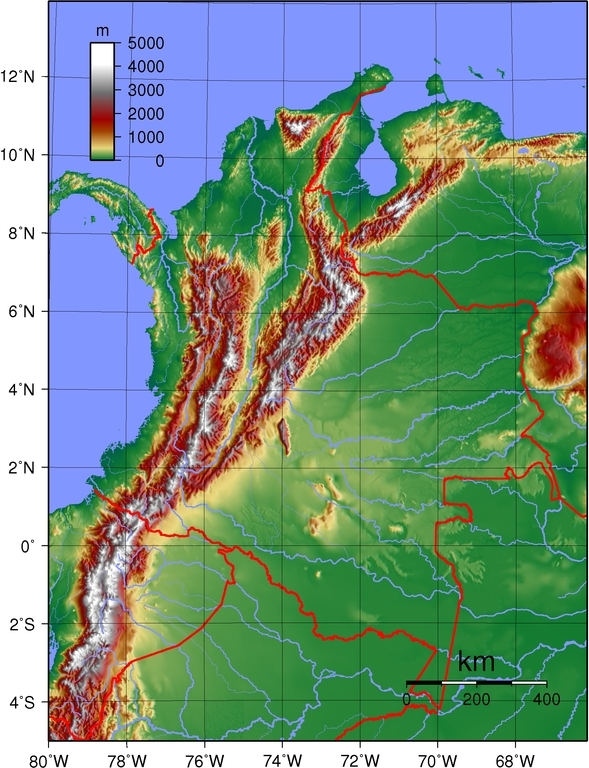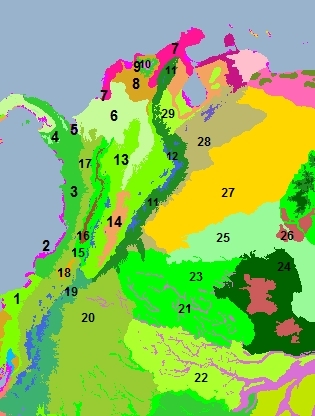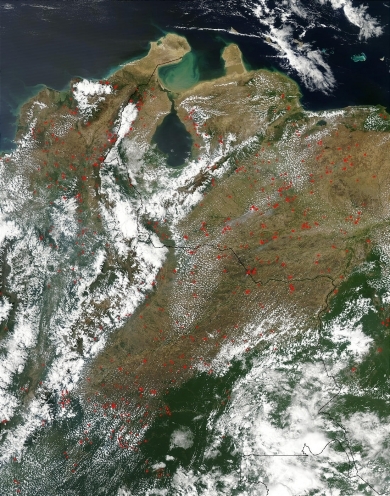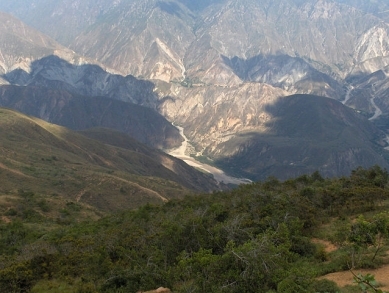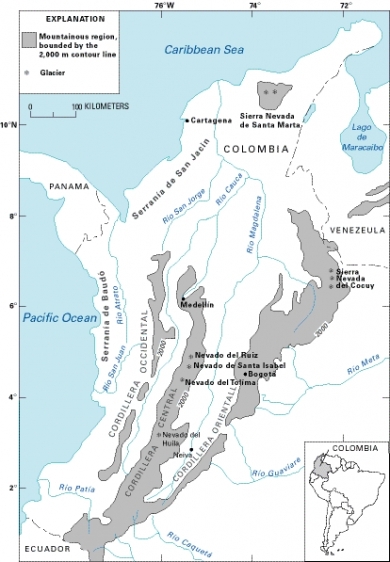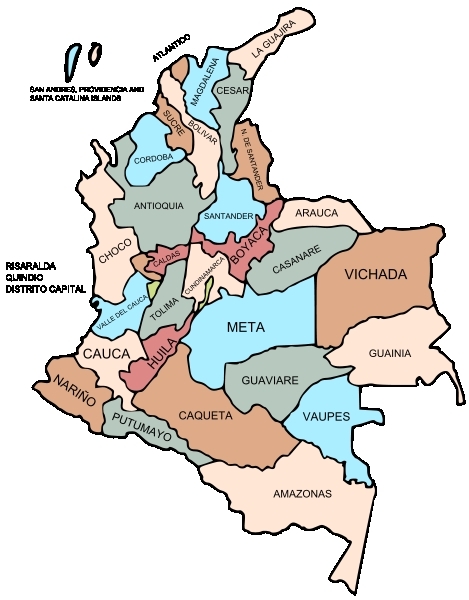Colombia
Countries and Regions of the World Collection  Columbia is a nation of forty-five million people in South American bounded in the northwest by the Central American nation of Panama (Ecoregions of Panama), in the east by Venezuela, in the south by Brazil, in the southwest by Peru and Ecuador.
Columbia is a nation of forty-five million people in South American bounded in the northwest by the Central American nation of Panama (Ecoregions of Panama), in the east by Venezuela, in the south by Brazil, in the southwest by Peru and Ecuador.
It is the only South American country with coastlines on both the North Pacific Ocean and Caribbean Sea.
Its main environmental issues include:
- deforestation (Deforestation in Amazonia);
- soil and water quality damage from overuse of pesticides; and,
- air pollution, especially in Bogota, from vehicle emissions.
It is susceptible to volcanic eruptions on the highlands; occasional earthquakes; and periodic drought.
Colombia was one of the three countries that emerged from the collapse of Gran Colombia in 1830 (the others are Ecuador and Venezuela).
A four-decade long conflict between government forces and anti-government insurgent groups, principally the Revolutionary Armed Forces of Colombia (FARC) heavily funded by the drug trade, escalated during the 1990s. The insurgents lack the military or popular support necessary to overthrow the government, and violence has been decreasing since about 2002. However, insurgents continue attacks against civilians and large areas of the countryside are under guerrilla influence or are contested by security forces.
More than 31,000 former paramilitaries had demobilized by the end of 2006 and the United Self Defense Forces of Colombia (AUC) as a formal organization had ceased to function.
In the wake of the paramilitary demobilization, emerging criminal groups arose, whose members include some former paramilitaries.
The Colombian Government has stepped up efforts to reassert government control throughout the country, and now has a presence in every one of its administrative departments. However, neighboring countries worry about the violence spilling over their borders.
Contents
Geography
Location: Northern South America, bordering the Caribbean Sea, between Panama and Venezuela, and bordering the North Pacific Ocean, between Ecuador and Panama
Geographic Coordinates: 4 00 N, 72 00 W
Area: 1,138,910 km2 (1,038,700 km2 land and 100,210 km2 water). This includes the tiny islands of Isla de Malpelo in the Pacific Ocean and Roncador Cay and Serrana Bank in theCaribbean Sea.
arable land: 2.01%
permanent crops: 1.37%
other: 96.62% (2005)
Land Boundaries: total: 6,309 km (Brazil 1,644 km, Ecuador 590 km, Panama 225 km, Peru 1,800 km, Venezuela 2,050 km
Coastline: 3,208 km (Caribbean Sea 1,760 km, North Pacific Ocean 1,448 km)
Maritime Claims:
territorial sea: 12 nm
exclusive economic zone: 200 nm
continental shelf: 200 m depth or to the depth of exploitation
Natural Hazards: Highlands are subject to volcanic eruptions; occasional earthquakes; periodic droughts.
Volcanism: Galeras (elev. 4,276 m) is one of Colombia's most active volcanoes, having erupted in 2009 and 2010 causing major evacuations. It has been deemed a "Decade Volcano" by the International Association of Volcanology and Chemistry of the Earth's Interior, worthy of study due to its explosive history and close proximity to human populations; Nevado del Ruiz (elev. 5,321 m), 129 km (80 mi) west of Bogota, erupted in 1985 producing lahars that killed 23,000 people. The volcano last erupted in 1991. Additionally, after 500 years of dormancy, Nevado del Huila reawakened in 2007 and has experienced frequent eruptions since then. Other historically active volcanoes include Cumbal, Dona Juana, Nevado del Tolima, and Purace.
Terrain: Flat coastal lowlands, central highlands, high Andes Mountains, eastern lowland plains. The highest point is Pico Cristobal Colon (5,775 metres). Nearby Pico Simon Bolivar also has the same elevation.
Climate: Tropical along coast and eastern plains; cooler in highlands.
Topography of Colombia. Source: Wikimedia Commons
Ecology and Biodiversity
The richest and most diverse region on Earth, the Tropical Andes covers a large portion of Colombia. The Tumbes-Chocó-Magdalena biodiversity hotspot extends through the Chocó region of western Colombia and spreads east around the northern extent of the Colombian western and central cordillera, through the dry forests along the Caribbean coast as far as the Sierra Nevada de Santa Marta, and south into the Cauca and Magdalena valleys. The Esmeraldes-Pacific Colombia mangroves extend along Colombia's Pacific coastline. The Magdalena-Santa Marta mangroves are located in northern Colombia in the Department of Magdalena encompassing the Gulfo de Urabá then east to just past the Sierra Nevada de Santa Marta at the base of the Guayjira Peninsula, along the Caribbean Sea. Colombia also has numerous biologically diverse terrestrial ecoregions:
Off shore: |
Ecoregions of Colombia. Source: World Wildlife Fund |
Parks and Protected areas
See main article: Protected areas of Colombia
Los Katíos National Park is located in northwest Colombia in the north of the Department of Chocó between the frontier with Panama and the west bank of the river Atrato. It is noted for it's diverse habitats and presence of flora and fauna specific to the Central and Southern American [[region]s].
|
In eastern Columbia (left) and northern Venezuela (right), a vast stretch of plains called the Llanos rests at the foothills of the Andes Mountains. The Moderate Resolution Imaging Spectroradiometer (MODIS) on the Terra and Aqua satellites detected numerous fires (red dots) scattered across the region, even in wetland areas between two of the Llanos’ majors rivers: the Apure (running from center toward the right of the image) and the Meta (flowing northeast from bottom left). Where the Meta leaves the Columbia-Venezuela border, it is joined by the Atabapo River and becomes the Orinoco, which flows out to meet the Atlantic. In the high-resolution imagery, dark purplish-brown burn scars are apparent against the green vegetation of the prairies. At bottom right (and most of the bottom of the Jan. 24 image), the grasses of the llanos give way to the upper reaches of the Amazon Rainforest. On Feb. 14, key-hole shaped Lake Maracaibo is visible in northwest Venezuela. On March 4, it is in the center. These images were captured in December 2002 and January and February 2003. Source: NASA. Credit: Jeff Schmaltz, MODIS Rapid Response Team, NASA/GSFC |
|
Two months of heavy rain have take a toll on northern Colombia. The rainy season, which runs from October to December, started with several days of intense rain in early October 2004 continued with torrential downpours through November. Many international aid agencies are calling this the most damaging rainy season in many years as floods and landslides claimed the lives of 19 people and left over 200,000 homeless. The Colombian government declared a state of emergency in eight provinces. |
| Street scene in the northern city of Cartagena. Because of the mild climate and abundance of wildlife in the area, settlement around Cartagena goes back to 7000 B.C. The city's colonial walled section and fortress have been designated a UNESCO World Heritage site. |
| Chicamocha canyon in the Department of Santander. Source: Wikimedia Commons. |
| Location of glaciers in Colombia. Mountains are delineated by the 2,000-m contour line (heavy dark line). Source: US Geological Survey |
People and Society
Population: 45,239,079 (July 2012 est.)
Colombia is the third-most populous country in Latin America, after Brazil and Mexico. Sixty-one cities have a population of 100,000 or more; five cities have a population of more than 1 million. Most of Colombia’s population is concentrated around the northern and western departments. The nine eastern lowlands departments, constituting about 54% of Colombia's area, are sparsely populated (less than 3% of the population; density of less than one person per square kilometer).
Ethnic and cultural diversity in Colombia reflects the indigenous, European (mainly Spanish), and African heritages of its inhabitants. Today, only about 3% of the people identify themselves as indigenous. Afro-Colombians and indigenous groups have faced challenges related to integration into mainstream Colombian society.
Around 37% of Colombians live below the poverty line, and the country continues to face large income disparities and inadequate social services. The history of the country, including decades of violence involving outlawed armed groups and drug cartels coupled with human rights violations, has complicated the advancement of government social programs to address these problems. Colombia continues to make progress in improving citizen security, which is an essential building block for stability and democracy.
Ethnic groups: mestizo 58%, white 20%, mulatto 14%, black 4%, mixed black-Amerindian 3%, Amerindian 1%
Age Structure:
0-14 years: 26.7% (male 6,109,495/female 5,834,273)
15-64 years: 67.2% (male 14,826,008/female 15,208,799)
65 years and over: 6.1% (male 1,159,691/female 1,587,277) (2011 est.)
Population Growth Rate: 1.128% (2012 est.)
Birthrate: 17.23 births/1,000 population (2012 est.)
Death Rate: 5.29 deaths/1,000 population (July 2012 est.)
Net Migration Rate: -0.66 migrant(s)/1,000 population (2012 est.)
Life Expectancy at Birth: 74.79 years
male: 71.55 years
female: 78.23 years (2012 est.)
Total Fertility Rate: 2.12 children born/woman (2012 est.)
Language: Spanish
Literacy: 92.8% (2004 est.)
Urbanization: 75% of total population (2010) growing at an annual rate of change of 1.7% (2010-15 est.)
History
During the pre-Columbian period, the area now known as Colombia was inhabited by indigenous societies ranging from hunters and nomadic farmers to the highly structured economy of the Chibchas, who are considered to have been one of the most developed indigenous groups in South America.
Santa Marta, the first permanent Spanish settlement, was founded in 1525. The city of Santa Fe de Bogota was founded in 1538 and, in 1717, became the capital of the Viceroyalty of New Granada, which included what are now Colombia, Venezuela, Ecuador, and Panama. Bogota was one of three principal administrative centers of the Spanish possessions in the New World.
On July 20, 1810, the citizens of Bogota created the first representative council to defy Spanish authority. Full independence was proclaimed in 1813, and in 1819 the Republic of Greater Colombia was formed to include all the territory of the former Viceroyalty of New Granada. Simon Bolivar was elected its first president with Francisco de Paula Santander as vice president. Conflicts between followers of Bolivar and Santander led to the formation of two main political parties, Liberal and Conservative. Bolivar's supporters, who formed the nucleus of the Conservative Party, sought strong centralized government, alliance with the Roman Catholic Church, and a limited suffrage. Santander's followers, forerunners of the Liberals, wanted a decentralized government, state control over education and other civil matters, and broader voting rights.
Throughout the 19th and early 20th centuries, each party held the presidency for roughly equal periods of time. Colombia maintained a tradition of civilian government and regular, free elections. Notwithstanding the country's commitment to democratic institutions, Colombia's history has been characterized by widespread and violent conflict. Two civil wars resulted from bitter rivalry between the Conservative and Liberal parties: The War of a Thousand Days (1899-1903), which claimed an estimated 100,000 lives, and La Violencia (the Violence) (1946-1957), which resulted in about 300,000 deaths.
La Violencia (The Violence) and the National Front
The assassination of Liberal leader Jorge Eliecer Gaitan in 1948 sparked the bloody conflict known as La Violencia. Conservative Party leader Laureano Gomez came to power in 1950, but was ousted by a military coup led by General Gustavo Rojas Pinilla in 1953. In 1957, Rojas was overthrown by the military with the support of the Liberal and Conservative Parties after he failed to restore democratic rule and was implicated in corrupt schemes.
In July 1957, an alliance between former Conservative President Laureano Gomez (1950-53) and former Liberal President Alberto Lleras Camargo (1945-46) led to the creation of the National Front. This established a power-sharing agreement between the two parties ending the partisan violence. Under the agreement, the presidency would be determined by regular rotating elections every 4 years, and the two parties would have parity in all other elected and appointed offices. This arrangement was phased out in 1978.
Post-National Front Years
During the post-National Front years, successive Colombian governments made efforts to negotiate peace with the guerrilla organizations that were flourishing in Colombia's remote and undeveloped rural areas. These organizations were rooted in Marxist ideologies and mobilized by student leaders in the 1960s. The groups persisted at low levels of organization until the 1980s, when they gained power. In 1984, President Belisario Betancur, a Conservative, negotiated a cease-fire with the Revolutionary Armed Forces of Colombia (FARC) and the Democratic Alliance (M-19) that included the release of many imprisoned guerrillas. However, the National Liberation Army (ELN) rejected the government's cease-fire proposal. The M-19 pulled out of the cease-fire and resumed fighting in 1985. The army suppressed an M-19 and drug cartel-coordinated attack on the Palace of Justice in Bogota in November 1985, during which 115 people were killed, including 11 Supreme Court justices. The government and the M-19 renewed their truce in March 1989, which led to a peace agreement and the M-19's demobilization and reintegration into society and political life. The M-19 was one of the parties that participated in the process to enact a new constitution (see below), which took effect in 1991. The FARC ended its truce in 1990 after 2,000-3,000 demobilized members were murdered. Many of those killed were members of the FARC political party Union Patriotica (UP), sanctioned by Bentacur during the peace negotiations. Those killed included the UP 1985 presidential candidate and elected congressmen. The identities of the assassins were not entirely clear, but a combination of government, paramilitary, and private entities was suspected.
Since the early 1980s, successive Colombian governments have had to contend with the terrorist and drug-trafficking activities of left-wing guerrillas, the rise of paramilitary self-defense forces in the 1990s, and the violence of drug cartels. Three presidential candidates were assassinated during the election campaign of 1990. After Colombian security forces killed Medellin cartel leader Pablo Escobar in December 1993, indiscriminate acts of violence associated with his organization abated as the cartels fragmented into multiple, smaller trafficking organizations that competed against one another in the drug trade. Guerrillas and paramilitary groups also entered into drug trafficking as a way to finance their military operations.
Pastrana Administration
The administration of Andres Pastrana (1998-2002), a Conservative, faced the challenges of increased countrywide attacks by the FARC and ELN, widespread drug production and associated crime, and the expansion of paramilitary groups. The Pastrana administration unveiled its "Plan Colombia" in 1999 as a 6-year strategy to deal with these longstanding problems and sought support from the international community. Plan Colombia was a comprehensive program to combat the narcotics trade, spur economic recovery, strengthen democratic institutions and respect for human rights, and provide humanitarian assistance to internally displaced persons.
In November 1998, Pastrana ceded a sparsely populated area the size of Switzerland in south-central Colombia to the FARC's control to serve as a neutral zone where peace negotiations could take place. The FARC negotiated with the government sporadically, while continuing to mount attacks against the military, communities, local authorities, and individuals and to expand coca production, which undermined the government's efforts to reach an agreement. Negotiations with the rebels in 2000 and 2001 were marred by rebel attacks, kidnappings, and fighting between rebels and paramilitaries for control of coca-growing areas in Colombia. In February 2002, after the FARC hijacked a commercial aircraft and kidnapped a senator, Pastrana ordered the military to attack rebel positions and reassert control over the neutral zone. The FARC withdrew into the jungle and increased attacks against Colombia's infrastructure but avoided large-scale direct conflicts with the military.
Uribe Administration
Alvaro Uribe, an independent, was elected president in May 2002 on a platform to restore security to the country. Among his promises was pursuing the broad goals of Plan Colombia within the framework of a long-term strategy. In the fall of 2002, Uribe released a democratic security strategy that employed political, economic, and military means to weaken all illegal armed groups. The Uribe government offered to negotiate a peace agreement with these groups if they would agree to a unilateral cease-fire and to end drug trafficking and kidnapping.
In December 2003, the Colombian United Self-Defense Forces (AUC) paramilitary group entered into a peace agreement with the government that led to the collective demobilization of over 31,000 AUC members. In addition, more than 20,000 members of the FARC, AUC, ELN, and other illegal armed groups have individually surrendered their arms. In July 2005, President Uribe signed the Justice and Peace Law, which provides reduced punishments for the demobilized if they renounce violence and return illegal assets, which are used by the government to provide reparations to victims.
In January 2007, Colombian leaders presented a new strategy to consolidate gains under Plan Colombia and its follow-on programs. This strategy eventually became known as the National Consolidation Plan (Plan Nacional de Consolidacion, or PNC). The PNC is a civilian-led, whole-of-government approach that builds upon successful Plan Colombia programs to establish state presence in traditionally ungoverned spaces. By improving access to social services, including justice, education, housing, and health; strengthening democracy; and supporting economic development through sustainable growth and trade, the Colombian Government seeks to permanently recover governance in Colombia's historically marginalized rural areas and break the cycle of guerilla violence.
In 2008, senior FARC commander Luis Edgar Devia-Silva, aka “Raul Reyes,” was killed during a Colombian Government operation; FARC Commander Manuel Munoz-Ortiz, aka “Ivan Rios,” was killed at the hands of his own chief of security; and FARC founding member Manuel Marulanda-Velez, aka “Tirofijo,” died from a reported heart attack. Since 2000, the FARC has not carried out large-scale multi-front attacks, although it has mounted some operations that indicate it has not yet been broken. Government efforts on peace negotiations with the FARC stalled in 2010.
Santos Administration
On August 7, 2010, Juan Manuel Santos was inaugurated as President of Colombia. He previously served as Minister of National Defense for Uribe’s second presidential term, as Minister of Finance under President Andres Pastrana, and as Minister of Trade under President Cesar Gaviria.
The Santos administration laid out an ambitious National Development Plan and has used a legislative majority to pass significant legislation, including a historic victims’ law that will benefit approximately 4 million Colombians over the next 10 years with reparations and land restitution. Santos reorganized the executive branch, including new ministries of justice, labor, and the environment and abolished the discredited Administrative Department of Security (DAS) and replaced it with a new civilian intelligence agency. Executive branch reform was mandated, including the redistribution of royalties from mineral/natural resources, fiscal reforms, and the implementation of more tools to improve citizen safety. To improve national policies going forward, Santos also created new presidential programs for Afro-Colombian and indigenous issues. Vice President Angelino Garzon, a respected former labor leader, coordinates human rights and labor right issues. He has promptly condemned human rights abuses and threats against unions.
The Santos administration has also maintained positive trends in security consolidation. Security forces captured, killed, or demobilized over 4,200 guerrillas and members of criminal gangs in 2010 and over 3,000 more in 2011. The number of FARC fighters has decreased from 16,000 in 2001 to approximately 8,000 in 2011. The Colombian police and military successfully coordinated operations that resulted in the death of top FARC military commander “Mono Jojoy,” ER-PAC (neo-paramilitary group) leader “Cuchillo,” and FARC Supreme Commander “Alfonso Cano.” Timoleon Jimenez, aka “Timochenko” was named Cano’s successor in 2011. The successful operation against Cano was the continuation of a government strategy of pursuing high-value targets (HVTs) to weaken guerilla groups. In August 2011, Santos announced a revised counter-insurgency plan focused on degrading the FARC and its networks through coordinated intelligence, smaller operations, consolidation, and better protection for law enforcement officials. President Santos has also clearly defined his government’s position on the possibility of peace negotiations--the FARC must release hostages, stop violence and lawlessness, and renounce the use of force to achieve political ends. Santos re-emphasized, in December 2011, that the unilateral release of hostages was a non-negotiable first step. In February 2012, the FARC announced it would return hostages and cease its policy of kidnapping hostages for ransom, but it remains to be seen whether it follows through. Since 2002, more than 54,000 paramilitaries and guerrillas have demobilized, while kidnappings have fallen 91%, homicides 45%, terrorist attacks 91%, and attacks against oil pipelines 71%. Colombian law enforcement interdicted over 125 metric tons (MT) of cocaine and cocaine base in 2011. As a result of nationwide efforts to improve security, travel on Colombia’s roads has doubled since 2000, and tourism has doubled since 2004.
The Victims and Land Restitution Law, signed into law by Santos in June 2011, focuses on making reparations available to 4 million victims affected by the country’s ongoing civil conflict. This landmark law, the implementation of which began in January 2012, offers monetary compensation to the victims of human rights violations such as forced disappearance or homicide. It also offers monetary compensation or land restitution to people who lost their land as a result of the conflict. If the land is now uninhabitable because it is not secure or is now a natural park or other protected place, compensation will be made in the form of equivalent land in another part of the country. If land restitution does not fully compensate for the loss of land, a monetary award will be made. Victims (and the families of these victims) who were guerillas or paramilitaries will not be eligible for compensation, and it is unclear whether victims of criminal bands or state violence will be eligible for compensation. The law will continue to aid past and current victims through 2021.
Building on the “democratic security” agenda of the previous administration, President Santos campaigned on “democratic prosperity,” focusing on economic development (jobs), security, and poverty reduction. The Santos administration passed an employment and formalization law, which seeks to create 2.5 million jobs, formalize 500,000 informal jobs, and reduce annual unemployment to single digits, all by 2014. His legislation to reduce the deficit through fiscal discipline measures was passed in late 2011.
In 2008, Colombia established an accusatorial judicial system, which should help critical human rights cases progress, but the country still needs to implement judicial reform legislation, provide more resources to the Prosecutor General, and show movement on emblematic human rights cases.
Colombia has taken an active, prominent role in global and regional institutions like the United Nations Security Council (UNSC) and the Union of South American Nations (UNASUR). Colombia chairs the Iran and Sudan Sanctions Committees in the UNSC, has contributed to three UN peacekeeping missions (Haiti, the Sinai, and Sierra Leone), and used its April 2011 UNSC presidency to focus attention on the reconstruction of Haiti. A Colombian is Secretary General of UNASUR until April 2012. Colombia will host the Summit of the Americas in April 2012 and the Pathways to Prosperity Ministerial Conference in October 2012. Additionally, Colombia has been sharing its unique security expertise throughout the region and globally through military and counternarcotics training exchanges with over 20 countries in Latin America, West Africa, and Afghanistan, and has committed to help the Central American Integration System (SICA) members. President Santos also successfully reestablished relations with Venezuela and Ecuador, allowing for greater collaboration on counternarcotics, border security, and trade.
Government
The 1991 constitution brought major reforms to Colombia's political institutions. While the new constitution preserved a presidential, three-branch system of government, it created institutions such as the Inspector General, a Human Rights Ombudsman, a Constitutional Court, and a Superior Judicial Council. It also re-established the position of Vice President. Other significant reforms in the 1991 constitution provided for civil divorce, dual nationality, and the establishment of a legal mechanism ("Tutela") that allows individuals to appeal government decisions affecting their constitutional rights and defined the state as pluri-ethnic, creating special seats for indigenous and Afro-Colombian representation in the Congress. The 1991 constitution also authorized the introduction of an accusatory system of criminal justice to be instituted gradually throughout the country, replacing the previous written inquisitorial system. A 2005 constitutional amendment allows the president to hold office for two consecutive 4-year terms.
Government Type: Republic; executive branch dominates government structure
Capital: Bogota - 8.262 million (2009)
Other Major Cities: Medellin 3.497 million; Cali 2.352 million; Barranquilla 1.836 million; Bucaramanga 1.065 million (2009)
|
Administrative divisions: 32 departments (departamentos, singular - departamento) and 1 capital district (distrito capital -- Bogota);
|
Independence Date: 20 July 1810 (from Spain)
Legal System: civil law system influenced by the Spanish and French civil codes. Colombia has not submitted an International Court of Justice (ICJ) jurisdiction declaration. It accepts International criminal court (ICCt) jurisdiction
International Environmental Agreements
Colombia is party to international agreements on Antarctic Treaty, Biodiversity, Climate Change, Climate Change-Kyoto Protocol, Desertification, Endangered Species, Hazardous Wastes, Marine Life Conservation, Ozone Layer Protection, Ship Pollution, Tropical Timber 83, Tropical Timber 94, and Wetlands.
Water
Total Renewable Water Resources: 2,132 cu km (2000)
Freshwater Withdrawal: 10.71 cu km/yr (50% domestic, 4% industrial, 46% agricultural)
Per Capita Freshwater Withdrawal: 235 cu m/yr (2000)
Access to improved sources of drinking water: 92% of population
Access to improved sanitation facilities: 74% of population
Energy
Colombia has seen an increase in oil production in recent years following a period of steady declines. The Colombian government has implemented a partial privatization of state oil company Ecopetrol in an attempt to revive its upstream oil industry. In addition, it has enacted a series of regulatory reforms to make the sector more attractive to foreign investors. Historically, the oil sector has been targeted by attacks from insurgent groups, though the situation has improved in recent years with a substantial reduction in the number of attacks against Colombia’s energy infrastructure. While the security situation has improved, Colombia's longstanding civil conflict has taken its toll on the country's energy sector, with the country’s pipelines and power lines still experiencing occasional sabotage by insurgent groups.
In 2006, Colombia consumed 1.3 quadrillion Btus of total energy. Oil constituted the largest part of this amount, followed by hydroelectricity. Colombia is also an important producer of high quality coal. Because Colombia relies upon hydropower for the bulk of its electricity needs, it is able to export almost all of its coal production, making it one of the world’s largest coal exporters.
See Energy profile of Colombia
Conflict
International Disputes:
- In December 2007, International Court of Justice allocated the Caribbean archipelago of San Andrés, Providencia and Santa Catalina islands to Colombia against a counterclaim by Nicaragua
- Managed dispute with Venezuela over maritime boundary and Venezuelan-administered Los Monjes Islands near the Gulf of Venezuela;
- Colombian-based illegal narcotics, guerrilla, and paramilitary activities penetrate all neighboring borders and have caused Colombian citizens to flee mostly into neighboring countries;
- Colombia, Honduras, Nicaragua, Jamaica, and the US assert various claims to Bajo Nuevo and Serranilla Bank
Economy
The Uribe administration (2002-2010) sought to maintain prudent fiscal policies and pursued tough economic reforms including tax, pension, and budget reforms. It opened the oil and gas sector in Colombia, forcing the state-owned petroleum company, Ecopetrol, to compete alongside private sector companies for exploration/production rights. This action led to increased foreign direct investment in the extractive industries and almost a doubling in oil production.
The Santos administration has been promoting economic growth through additional economic reforms and by pursuing free trade agreements with other South American and Asian countries, as well as with the European Union, the United States, and Canada. The average unemployment rate in 2011 (Jan.-Nov.) was around 10.9%, down from 12% in 2009. Despite recent improvements in Colombia’s economy, the country continues to have a high rate of poverty (37.2%) and one of the highest levels of income disparity in the world.
Colombia's economic growth in the last decade can be attributed to an increase in security, resulting in greater foreign investment; economic reforms in the oil and gas sectors; prudent monetary policy; and export growth fueled in part by the Andean Trade Promotion and Drug Eradication Act (ATPDEA) of 2002. Investments as a percentage of GDP were around 28% in mid-2011, which was higher than both Brazil and Chile.
Economists projected growth of up to 6% for 2011, and Colombia’s third-quarter 2011 GDP growth was 7.7%. It is estimated that the economy will grow between 4% and 5% in 2012. Per capita GDP has doubled since 2002, while unemployment fell from 15.7% in 2002 to 9.2% in November 2011. Colombia has concluded or is pursuing free trade agreements (FTAs) with the EU, Turkey, Panama, South Korea, Japan, Switzerland (July 2011), Canada (August 2011) and the United States (ratified in October 2011 with entry into force expected in 2012). It also has trade agreements with Mexico, Chile, Central America, the Andean Community of Nations, and Mercosur.
Industry and Agriculture
As the most industrially diverse member of the Andean Community, Colombia has five major industrial centers--Bogota, Medellin, Cali, Barranquilla, and Bucaramanga--each located in a distinct geographical region. Colombia's industries include mining (coal, gold, and emeralds), oil, textiles and clothing, agribusiness (cut flowers, bananas, sugarcane, and coffee), beverages, chemicals and petrochemicals, cement, construction, iron and steel products, and metalworking. There is also a burgeoning service economy comprised of tourism and information technology exports (call centers, software development, and animation).
Colombia's diverse climate and topography permit the cultivation of a wide variety of crops. In addition, all regions yield forest products, ranging from tropical hardwoods in the lowlands, to pine and eucalyptus in the colder areas. Cacao, sugarcane, coconuts, bananas, plantains, rice, cotton, tobacco, cassava, and most of the nation's beef cattle are produced in the hot regions from sea level to 1,000 meters elevation. The temperate regions--between 1,000 and 2,000 meters--are better suited for coffee, flowers, corn and other vegetables, pears, pineapples, and tomatoes. The cooler elevations--between 2,000 and 3,000 meters--produce wheat, barley, potatoes, cold-climate vegetables, flowers, dairy cattle, and poultry.
Labor
While Colombia continues to face challenges in terms of labor rights, it has committed to sweeping reforms under the Labor Action Plan announced by Presidents Obama and Santos on April 7, 2011. The Colombian Government has committed to doubling the labor inspectorate by hiring 480 inspectors over the next 4 years. A significant number of these inspectors will be dedicated to addressing worker rights abuses in the palm oil, sugar, mines, ports, and flowers sectors. Preventive inspections in these sectors and for temporary service agencies have already begun. New legislation also establishes criminal penalties, including imprisonment, for employers that undermine the right to organize and bargain collectively or threaten workers who exercise their labor rights. In November 2011, the Government of Colombia established a separate Labor Ministry and appointed new Labor Minister Rafael Pardo to provide better institutional capacity to protect labor rights.
To address issues of impunity in crimes against labor unionists, the Colombian Government exceeded its Action Plan commitments in appointing 100 full-time judicial police inspectors for labor violence cases, and has developed improved training for judicial police investigators and prosecutors on such cases. Priority labor violence cases remain open, but Colombia is showing a commitment to reduce the number of unresolved cases. The Colombian Government has also expanded its protection program for threatened union activists, and reduced the backlog of risk assessments for unionists applying for protection.
Trade
Colombia is the United States' fourth-largest export market in Latin America behind Mexico, Brazil, and Chile. U.S. exports to Colombia from January through November 2011 were $13.1 billion, up 20% from the previous year. U.S. imports from Colombia from January through November 2011 were $20.9 billion, up 47% from 2010 due to high crude oil prices and the weak dollar. Colombia's major exports are petroleum, coal, coffee, nickel, cut flowers, and bananas. The United States is Colombia's largest trading partner, representing about 42% of Colombia's exports and 26% of its imports as of November 2011. Colombia is the United States’ sixth-largest supplier of crude oil (September 2011).
Mining and Energy
Colombia is a fast-growing market with a good investment climate and is increasingly seen as a regional leader in trade and security. Colombia has considerable mineral and energy resources, especially coal and natural gas reserves. Mining and energy-related investments have grown because of higher oil prices, increased demand, improved output, and pro-business reforms, along with improved security conditions. Improved security has allowed for greater economic and social development and helped attract higher levels of foreign direct investment, particularly in extractive industries (crude oil, natural gas, and coal). These reforms have significantly liberalized Colombia’s petroleum sector, leading to an increase in exploration and production contracts from both large and small hydrocarbon industries. Ecopetrol was the first Colombian company to earn a spot in the Fortune 500.
Natural Gas. In 2011, natural gas reserves totaled 5.4 trillion cubic feet. Natural gas production totaled 1.031 million cubic feet per day on average during 2011 (Jan.-Nov.).
Crude Oil. Crude oil production has nearly doubled since 2007, reaching 965,000 barrels per day (bbl/d) in November 2011. Colombia had 2.0 billion barrels of proven crude oil reserves in 2010, the fifth-largest in South America.
Refining Capacity. The country's current oil-refining capacity is 325,000 bbl/d, but is expected to grow to 415,000 in 2016 according to the Ministry of Mines and Energy after renovations to its two largest refineries in Cartagena and Barrancabermeja.
Coal. As of 2010, Colombia was the tenth-largest coal producing country and the fifth-largest coal exporting country in the world. It is the largest coal producer in Latin America (74.3 million tons in 2010). Colombia also is the largest exporter of coal to the United States.
Gems. Colombia historically has been the world's leading producer of emeralds and after a short lull in production it has returned to being a leader in this field. Emerald production rose to 5.23 million carats in 2010, up from 2.12 million carats in 2008.
Precious Metals. Colombia is also a significant producer of gold (53.6 tons in 2010), silver (15.3 tons in 2010), and platinum (1 ton in 2010).
Foreign Investment
Foreign direct investment (FDI) inflows totaled $6.76 billion in 2010, with most investment concentrated in extractive industries. FDI was reaching historic levels as of third-quarter 2011; it was U.S. $10.8 billion, equaling its record year in 2008. The Colombian Ministry of Finance predicted that total 2011 FDI might reach U.S. $13 billion. According to Central Bank data, this would represent the largest inflow of FDI in Colombia’s history. On average, the United States has been the largest source of new FDI in Colombia, particularly in mining and hydrocarbon projects. The bulk of total new investment in Colombia is in the manufacturing, mining, and energy sectors. The only activities closed to foreign direct investment are defense, national security, and disposal of hazardous wastes.
All three major ratings agencies have upgraded Colombia's investment grade. Nevertheless, Colombia depends heavily on oil exports, making it vulnerable to a drop in oil prices. Economic development is stymied by inadequate infrastructure, weakened further by recent flooding. Moreover, the 9.2% official unemployment rate is still one of Latin America's highest.
Inequality, underemployment, and narcotrafficking remain significant challenges, and Colombia's infrastructure requires major improvements to sustain economic expansion.
In late 2010, Colombia experienced its most severe flooding in decades, with damages estimated to exceed $6 billion. The rains resumed in 2011, causing further damages to crops and infrastructure, as well as killing hundreds of Colombians and displacing millions.
GDP: (Purchasing Power Parity): $467 billion (2011 est.)
GDP: (Official Exchange Rate): $321.5 billion (2011 est.)
GDP- per capita (PPP): $10,100 (2011 est.)
GDP- composition by sector:
agriculture: 8.9%
industry: 38%
services: 53.1% (2011 est.)
Industries: textiles, food processing, oil, clothing and footwear, beverages, chemicals, cement; gold, coal, emeralds
Natural Resources: petroleum, natural gas, coal, iron ore, nickel, gold, copper, emeralds, hydropower.
Currency: Colombian Peso (COP)
Further Reading
